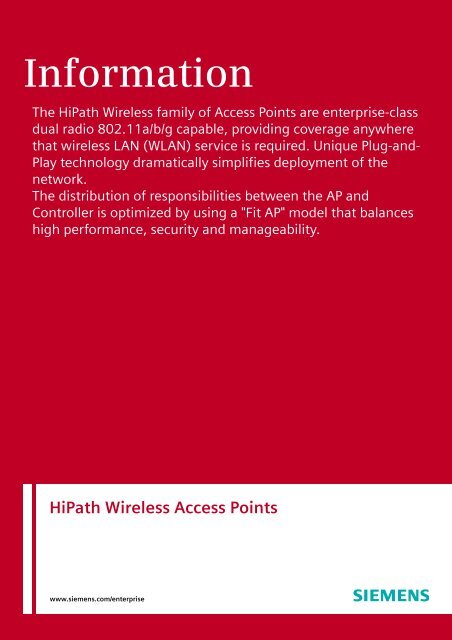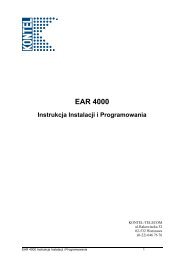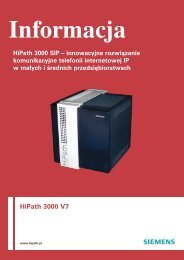Information HiPath Wireless Access Points - NET Systems Kraków
Information HiPath Wireless Access Points - NET Systems Kraków
Information HiPath Wireless Access Points - NET Systems Kraków
You also want an ePaper? Increase the reach of your titles
YUMPU automatically turns print PDFs into web optimized ePapers that Google loves.
<strong>Information</strong><br />
The <strong>HiPath</strong> <strong>Wireless</strong> family of <strong>Access</strong> <strong>Points</strong> are enterprise-class<br />
dual radio 802.11a/b/g capable, providing coverage anywhere<br />
that wireless LAN (WLAN) service is required. Unique Plug-and-<br />
Play technology dramatically simplifies deployment of the<br />
network.<br />
The distribution of responsibilities between the AP and<br />
Controller is optimized by using a "Fit AP" model that balances<br />
high performance, security and manageability.<br />
<strong>HiPath</strong> <strong>Wireless</strong> <strong>Access</strong> <strong>Points</strong><br />
www.siemens.com/enterprise
The <strong>HiPath</strong> <strong>Wireless</strong> solution optimizes the<br />
processing load between the <strong>Access</strong> Point<br />
and Controller using a "Fit AP" to deliver exceptional<br />
performance while remaining<br />
easy to manage. <strong>HiPath</strong> <strong>Wireless</strong> APs can<br />
handle the full processing load for certain<br />
applications, providing an unmatched level<br />
of flexibility and performance for complex,<br />
time-sensitive functions including QoS, encryption,<br />
RF management, and rogue AP<br />
detection. Global functions like configuration,<br />
roaming, security management, and<br />
policy control are centralized at the Controller.<br />
The result is a WLAN infrastructure that<br />
can easily be expanded to support advanced<br />
Open Mobile Enterprise Solutions.<br />
Furthermore, <strong>HiPath</strong> <strong>Wireless</strong> is ideally suited<br />
to accommodate new high-performance<br />
technologies such as VoWLAN and<br />
802.11n.<br />
Ease of Deployment &<br />
Management Control<br />
Deploy WLAN anywhere<br />
The <strong>HiPath</strong> <strong>Wireless</strong> AP models are designed<br />
to provide optimal RF coverage in almost<br />
any environment. The AP2610 uses discrete<br />
internal antennas, while the AP2620 features<br />
directional external antennas to allow<br />
extended coverage and minimal interference<br />
in hard-to-reach areas like hallways or<br />
behind pillars. Indoor access points can be<br />
mounted on walls or ceilings, or kept completely<br />
out of sight by mounting them<br />
above suspended ceilings (plenum mounted).<br />
<strong>Wireless</strong> Distribution System (WDS) -<br />
uses RF to provide network access and<br />
bridge traffic back to the wired network<br />
making it possible to extend the network to<br />
less traditional locations (outdoors), for<br />
campus-wide access, without installing additional<br />
cable or fiber.<br />
Outdoor <strong>Access</strong> Point<br />
The Outdoor <strong>Access</strong> Point AP2650/AP2660<br />
(OAP) allows installations to seamlessly<br />
span from office to factory floor to outdoors.<br />
Featuring the same capabilities of<br />
the 2610 and 2620 models, the OAP is designed<br />
to deliver enterprise WLAN coverage<br />
in the harshest industrial or outdoor environments.<br />
The OAP features an internal or<br />
external antenna option, stable and robust<br />
housing which withstands extreme temperature<br />
ranges, and is dust, dirt, salt water,<br />
fog and humidity resistant.<br />
Secure wired network integration<br />
<strong>HiPath</strong> <strong>Wireless</strong> APs can authenticate with<br />
802.1x-secured switches whenever they<br />
are connected to the wired network. This<br />
ensures that all Ethernet connections are<br />
only used by authorized devices.<br />
Dual band, multi SSID flexibility<br />
Each AP houses two independently manageable<br />
radios, one for 802.11b/g (2.4 GHz<br />
band) and one for 802.11a (5 GHz band).<br />
Each radio supports up to eight separate<br />
SSIDs, each with its own configuration, security<br />
and policy settings. As a result, there<br />
are sixteen "virtual APs" for every physical<br />
unit. This can be used to enable an additional<br />
level of security and quality by separating<br />
specific types of traffic or groups of users on<br />
to different SSIDs. This segmentation is in<br />
addition to the Virtual Network Services<br />
user management supported by the<br />
<strong>HiPath</strong> <strong>Wireless</strong> Controller providing unprecedented<br />
yet flexible network management.<br />
"Plug & Play" network installation<br />
A <strong>HiPath</strong> <strong>Wireless</strong> <strong>Access</strong> Point will automatically<br />
register itself with an available<br />
Controller and download its configuration.<br />
The AP can immediately provide service to<br />
users without having to be manually configured.<br />
New AP registration with the<br />
Controller is handled securely, ensuring<br />
that only authorized APs are recognized.<br />
Central configuration and monitoring<br />
All APs associated with a Controller are individually<br />
monitored and managed. When<br />
needed, each AP can be separately configured,<br />
enabled, or disabled. APs can be managed<br />
through the Controller via SNMP,<br />
which provides alarms, traps and reporting<br />
statistics suitable for network managers.<br />
APs also provide consolidated reports for<br />
performance management, security logging,<br />
and usage data.<br />
Authentication and encryption<br />
<strong>HiPath</strong> <strong>Wireless</strong> APs use the most sophisticated<br />
technology standards to ensure sufficient<br />
security and client compatibility.<br />
Based on the 802.11i (WPA 1/2), industry<br />
standards for wireless security, implementations<br />
provide 802.1x or Pre-Shared Key<br />
authentication and AES, TKIP or WEP encryption.<br />
AP2610 AP2610<br />
Proactive wireless intrusion detection<br />
and prevention<br />
APs scan different RF channels at regular intervals<br />
– while also providing network access<br />
to users – to identify all wireless nodes<br />
within their airspace. This information is<br />
then passed on to the <strong>HiPath</strong> <strong>Wireless</strong><br />
Controller, where it is consolidated for review<br />
by network administrators. Integrating<br />
<strong>HiPath</strong> <strong>Wireless</strong> Manager HiGuard enhances<br />
this process by consolidating AP scan information<br />
into compliance reports.<br />
Dynamic RF management and load<br />
balancing for reliable performance<br />
<strong>HiPath</strong> <strong>Wireless</strong> APs work together to deliver<br />
interference prevention and load sharing.<br />
Each AP is able to intelligently and dynamically<br />
adjust its transmit power and channel<br />
selection based on user position and information<br />
from nearby APs. This process,<br />
known as Dynamic RF Management, ensures<br />
optimal performance for associated<br />
clients. If an AP fails, neighboring APs will<br />
increase power to maintain coverage in the<br />
affected area, maintaining a consistent<br />
high level of performance despite the dynamic<br />
and inconsistent nature of RF traffic.<br />
Solutions Enablement<br />
Capabilities<br />
End-to-end VoWLAN<br />
<strong>HiPath</strong> <strong>Wireless</strong> APs are optimized for the industry’s<br />
leading VoWLAN devices to ensure<br />
peak call quality and reliability. Support for<br />
WMM-UAPSD will maximize phone battery<br />
life.<br />
QoS for real-time voice & multi-media<br />
<strong>Wireless</strong> Quality of Service is delivered via<br />
the WMM standard for traffic prioritization,<br />
which is based on the 802.11e industry<br />
standard. Priorities can also be set according<br />
to SSID, allowing critical real-time traffic<br />
to be assigned to a distinct high-priority<br />
queue. Interoperability with prioritization<br />
mechanisms on the wired network is also<br />
available to ensure end-to-end QoS. Call <strong>Access</strong><br />
Control ensures that high quality voice<br />
traffic is maintained in existing calls before<br />
admitting new traffic onto the access point.<br />
Outdoor AP<br />
AP2650/AP2660
<strong>HiPath</strong> <strong>Wireless</strong> <strong>Access</strong> Point Supported Features<br />
Management<br />
Security<br />
Performance<br />
Voice<br />
Capacity<br />
Feature Benefit<br />
Plug ‘n Play Installation:<br />
– Automatic Controller Discovery<br />
– Centrally-deployed Configurations<br />
and Upgrades<br />
– Network-independent<br />
<strong>HiPath</strong> <strong>Wireless</strong> Portfolio<br />
No on-site configuration needed, dramatically<br />
reducing deployment time and costs.<br />
Secure Remote Management APs can be easily configured and monitored from a<br />
central location with less personnel.<br />
Up to 16 SSIDs (8 per radio) Segment networks based on distinct user access,<br />
performance, and security needs.<br />
Security via WEP, WPA, (TKIP), WPA2,<br />
(AES), 802.11i, 802.1x<br />
Latest authentication and encryption standards ensure<br />
that user data is safe.<br />
VPN Support: IPSec, PPTP, L2TP VPN interoperability provides added security.<br />
Rogue AP Detection APs participate in the detection and prevention of<br />
unauthorized APs or ad hoc networks.<br />
Intelligent Fit AP Encryption, filtering, QoS, and RF management done<br />
by the AP, resulting in high performance and resilience<br />
if the rest of the network fails.<br />
Client Load Balancing and Failover Client load balancing and failover - ensures APs run<br />
optimally; load balancing protects the AP from overuse,<br />
failover keeps the AP operating in the event of a<br />
controller failure.<br />
Dynamic RF Management (DRM) APs intelligently discover network gaps, and can<br />
increase transmit power to maintain coverage.<br />
802.11a/b/g WLAN Connectivity Greater user interoperability and performance.<br />
Quality of Service (WMM, 802.11e) Optimal performance for media and voice applications.<br />
Fast, Secure Roaming and Handover<br />
(pre authentication, OKC)<br />
Simultaneous Voice Calls: 12<br />
(802.11b, G.711, R>80)<br />
Voice session integrity is preserved in a secure manner,<br />
even when users move across APs.<br />
APs meet the quality and capacity demands of today's<br />
VoIP applications.<br />
Simultaneous Users: 127 per radio Managers can stretch their investment further.<br />
The Foundation for Mobility<br />
Fixed Mobile Convenience is central to Siemens’<br />
Open Communications strategy, enabling<br />
enterprises to communicate and<br />
collaborate with any device on any network,<br />
in any IT environment. Siemens’ secure,<br />
scalable, and centrally managed<br />
Enterprise-wide Foundation for Mobility<br />
portfolio enables Fixed Mobile Convenience<br />
and eases the deployment of Open Mobile<br />
Enterprise Solutions.<br />
<strong>HiPath</strong> <strong>Wireless</strong> is the leading enterprise<br />
WLAN for deploying secure, optimized<br />
voice and data solutions. <strong>HiPath</strong><br />
MobileConnect is the industry’s most comprehensive<br />
extension of enterprise communications<br />
into the mobile network. Few can<br />
match Siemens’ unique array of products<br />
and industry expertise to drive mobility<br />
throughout the enterprise – and beyond.
<strong>HiPath</strong> <strong>Wireless</strong> <strong>Access</strong> Point Specifications<br />
AP2610/AP2620 Outdoor AP (OAP) AP2650/AP2660<br />
Data rates ● 802.11a: 6, 9, 12, 18, 24, 36, 48, 54 Mbps<br />
● 802.11b: 1, 2, 5.5, 11 Mbps<br />
● 802.11g: 1, 2, 5.5, 6, 9, 11, 12, 18, 24, 36, 48, 54 Mbps<br />
Frequency bands 802.11a:<br />
● 5.15 to 5.25 GHz (FCC / IC / ETSI)<br />
● 5.25 to 5.35 GHz (FCC / IC / ETSI)<br />
● 5.47 to 5.725 GHz (ETSI)<br />
● 5.725 to 5.825 GHz (FCC / IC)<br />
802.11b/g:<br />
● 2.400 to 2.4835 GHz (FCC / IC / ETSI)<br />
Dynamic channel<br />
control<br />
DFS & TPC support (ETSI)<br />
<strong>Wireless</strong> modulation ● 802.11a: OFDM<br />
● 802.11b: DSSS<br />
● 802.11g: DSSS and OFDM<br />
Antennas Integrated Antenna (AP2610 only)<br />
2.4 / 5.0 GHz - 4 dBi Gain<br />
External Antenna (AP2620 only)<br />
2.4 GHz / 5.0 GHz - 4 / 5 dBi Gain<br />
Customers can purchase approved directional and omnidirectional<br />
antennas with a selection of antenna gain.<br />
802.11a:<br />
● 5.15 to 5.25 (FCC / IC / ETSI)<br />
● 5.25 to 5.35 GHz (ETSI)<br />
● 5.47 to 5.725 GHz (ETSI)<br />
● 5.725 to 5.825 GHz (FCC / IC)<br />
802.11b/g<br />
● 2.400 to 2.4835 GHz (FCC / IC / ETSI)<br />
Interface & indicators Auto-sensing 10/100bT Ethernet interface. LED indicating AP status and connectivity<br />
Receive sensitivity<br />
(typical)<br />
● 802.11a: 6 Mbps/-89 dBm, 36 Mbps/-78 dBm, 48 Mbps/-73 dBm, 54 Mbps/-70 dBm<br />
● 802.11b: 1 Mbps/-91 dBm, 2 Mbps/-90 dBm, 5.5 Mbps/-89 dBm, 11 Mbps/-87 dBm<br />
● 802.11g: 6 Mbps/-89 dBm, 36 Mbps/-79 dBm, 48 Mbps/-74 dBm, 54 Mbps/-72 dBm<br />
Power ● 802.3af Power over Ethernet, Class 0<br />
(12.95 Watts Max)<br />
● Typical Power: 9.75 Watts DC Power<br />
● Voltage: +6 V DC<br />
● Current: 1700 mA max. at +6 V DC<br />
Available transmit<br />
power<br />
Integrated Antenna<br />
3dBi@2,4 GHz, 4dBi@5 GHz<br />
External Antenna<br />
Various high gain directional and omni-directional antennas are<br />
approved.<br />
● 802.3af Power over Ethernet – 12.9W<br />
● 48V DC – 15W<br />
● 110-230V AC -15W<br />
● 802.11a: – 5.15 to 5.25 GHz: 17 dBm (FCC/IC), 18 dBm (ETSI); 5.25 to 5.35 GHz: 18 dBm (FCC/IC/ETSI)<br />
– 5.470 to 5.725 GHz: 18 dBm (ETSI); – 5.725 to 5.850 GHz: 15 dBm (FCC / IC)<br />
● 802.11b/g: 18 dBm (FCC / IC),15 dBm (ETSI); Transmit (selectable per radio): – 100%, 50%, 25%, 12.5%, 6.25%<br />
Compliance/standards Ethernet IEEE 802.3 / 802.3u / 802.3af; <strong>Wireless</strong> IEEE 802.11a/b/g; WPA, WPAv2, WMM<br />
Safety UL / IEC / EN 60950 ; CAN/CSA 22.2 # 60950-1-03<br />
UL 2043 Plenum Rating<br />
EMC & Radio FCC CFR 47 Part 15, Class B<br />
ICES-003 Class B; FCC Subpart C 15.247;<br />
FCC Subpart E 15.407; RSS-210;<br />
EN 301 893 V1.2.3; EN 300 328 V1.6.1;<br />
EN 301 489 1 & 17; EN / UL 60601-1-2;<br />
EN 50385<br />
EN 55011 (CISPR 11) Class B Group 1ISM<br />
Dimensions & weight 40 mm x 115 mm x 175 mm (1.5" x 4.5" x 7")<br />
AP2610 weight: 272 g (9.6 oz)<br />
AP2620 weight: 363 g (12.8 oz)<br />
Environmental ● Operating Temp: 5ºC to 40ºC (41ºF - 104ºF)<br />
● Storage Temp: -40ºC to 85ºC (-40ºF - 185ºF)<br />
● Humidity (Non-Condensing): 10 to 95%<br />
EN 60950<br />
EN 301 489-1 V1.6.1;<br />
EN 301 489-17 V1.2.1;<br />
EN 300 328 V1.6.1;<br />
EN 301 893 V1.3.1;<br />
EN 50385;<br />
1999/519/EC;<br />
FCC CFR 47 Part 15, Class B<br />
(W x H x D) 251 mm x 251 mm x 72 mm<br />
Without PS adaptor: 2241g<br />
With AC PS adaptor: 2433g<br />
● Operating Temp: -40ºC to 70ºC<br />
● Storage Temp: -40ºC to 85ºC<br />
● Protection – IP65, NEMA 4x<br />
● Humidity 95%, MTBF – 61 years<br />
For more detailed and up-to-date specifications, please visit http://www.siemens.com/enterprise<br />
Copyright © Siemens Enterprise<br />
Communications GmbH & Co. KG 11/2007<br />
Hofmannstr. 51, D-81359 München, Germany<br />
Reference No.: A31002-W1050-D101-2-7629<br />
The information provided in this document contains merely<br />
general descriptions or characteristics of performance which<br />
in case of actual use do not always apply as described or<br />
which may change as a result of further development of the<br />
products. An obligation to provide the respective characteristics<br />
shall only exist if expressly agreed in the terms of con-<br />
www.siemens.com/enterprise<br />
tract. Availability and technical specifications are subject to<br />
change without notice. The trademarks used are owned by<br />
Siemens Enterprise Communications GmbH & Co. KG or their<br />
respective owners.




